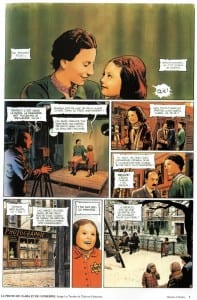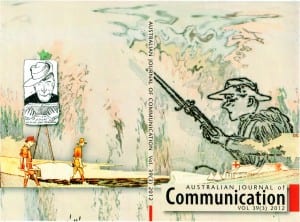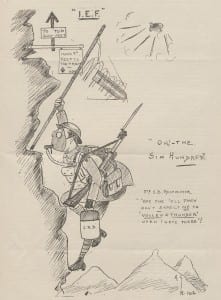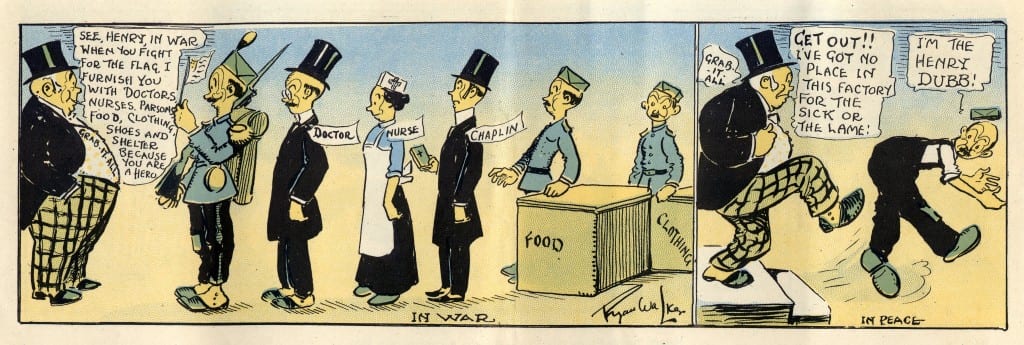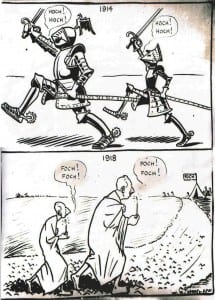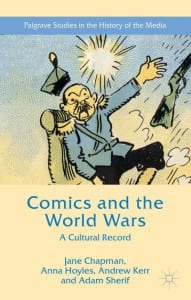Comics and the World Wars
The team of five researchers, led by Professor Jane Chapman, have studied over 15 000 comic strips from three continents.
Jane Chapman
Prof. Jane Chapman is a comparative media historian. She specialises in amateur WW1 British and Dominion proto comic strips produced by soldiers in their trench publications, and in comic strips and books from occupied France during WW2. Her chapter on the former appears in the monograph Comics and the World Wars – A Cultural Record. Prof. Chapman has also written about ‘Paroles d’Etoiles’ – a series of radio interviews with verbatim personal testimonials that were printed first in book form, followed by a comic book, depicting memories of hidden Jewish children who had fled the Holocaust and were forced to assume false identities to survive. This work is published in the Pivot mini-monograph Comics, the Holocaust and Hiroshima.
Prof. Chapman has published in several journals on WW1 and the Dominions as well as on gender in Australian comics during the Second World War, when women were recruited for the first time to the armed forces – a subject covered in a journal article and in book chapters. She is editorial lead for the team’s publications of two monographs for Palgrave Macmillan (2015), and is a specialist consultant for BBC WW1 centenary and VE Day programming. She is also a co-investigator for the AHRC/HLF funded Everyday Lives in War.
For information on Prof. Chapman’s other publications please see her staff profile.
Dan Ellin
Dan has undertaken research into cartoons included in First World War ‘trench publications’; primitive newspapers often produced by the men themselves just behind the front line. He has found around a hundred examples of early comic strips in British, Canadian, Anzac and American trench publications and identified common themes within them. This has led to the publication of two articles with Jane Chapman: ‘Multi-panel
comic narratives in Australian First World War trench publications as citizen journalism’, Australian Journal of Communication, 39, 3, 2012, p. 1-22 and ‘Dominion cartoon satire as trench culture narratives: Complaints, endurance and stoicism’ in The Round Table: The Commonwealth Journal of International Affairs,103(2) 175-192.
He has also written the chapter ‘Barefoot Gen and Hiroshima: Comic strip narratives of trauma’ for the Palgrave Pivot mini-monograph Comics, the Holocaust and Hiroshima. Using literary criticism’s ‘trauma theory’, and largely focusing on Keiji Nakazawa’s Barefoot Gen, his chapter discusses the ability of a sequential pictorial narrative to depict the traumatic experience of Hibakusha (Atomic bomb survivors).

Courtesy of Last Gasp, images to appear in the book Comics, the Holocaust and Hiroshima (forthcoming, Palgrave Macmillan, 2015)
Anna Hoyles
Anna’s work explores the comic strips of Australasian and North American socialist and trade union publications during the Great War. Above all, she is interested in the recurrence of a certain type of character, ‘the gullible worker’ – a foolish, non-heroic Everyman who believes that his employers, the politicians and the newspapers are always right and that labour movement activists are invariably wrong. She is researching his significance to the labour movement (several ‘gullible workers’, such as Mr Block and Henry Dubb, became household names) and the extent of his geographical distribution.
Continuing the labour movement theme, the second part of her study analyses aspects of the comic strip ‘The Front Line’, published by the Communist Party of Great Britain’s newspaper, the Daily Worker, during the Second World War. In particular, Anna is looking at the changes to the strip before and after the ban of the Daily Worker by the Home Secretary (Jan 1941-Sept 1942).
In both of the above cases, which appear in two of the chapters of the Comics and the World Wars monograph, she is interested in what part comic strips and humour played within these organisations and how the former can fulfil a valuable role as a historiographical source in broadening our understanding of these groups.
Andrew Kerr
The history of the phenomenon we now refer to as a “comic”, whether we follow the phrase with “strip” or “book”, is well known. The historical role that comic strips and comic books have played and their effect on the species that developed them as a medium of
communication, however, is not. From the work of the artist W.K. Haselden, who depicted life on the British Home Front, to news stand depictions of the Japanese during the battles in the South Pacific – Andrew’s research analyses historical evidence from both world wars in order to tease out the influence that comics have had upon the hearts, minds, and opinions of people and nations involved in both conflicts. His project, entitled ‘Heroes & Villains: Reality & Imagination’, focuses on how characters are represented in comics and the cultural significance these representations had as vehicles for wartime entertainment and propaganda. For the Palgrave monograph, Comics and the World Wars – A Cultural Record, he has contributed chapters on Haselden and on comics as propaganda as well as work on the ‘pin-up strips’ ‘Male Call’ and ‘Sad Sack’.
Adam Sherif
With the title ‘Forgotten History – Gender & Ethnicity’, Adam’s research sets out to examine US comic books of the Second World War within the rigid confines of historical analysis. Through integration with more conventional sources and in conjunction with the relevant historiography, he is seeking to establish to what extent comics can be considered historical evidence, in what different senses they may be said to be a record, and finally, what contribution the medium can make to established debates. His empirical work consists of two case study historical questions. The first focuses on the roles of women at war. Adam is examining what insights comic books can offer relative to discussions of contemporary attitudes towards the presence (and action) of women in the theatre of war and has written on the subject for the monograph Comics and the World Wars – A Cultural Record. He has also contributed a proposed theory and method for the incorporation of comic books as primary sources.
With the second case study, on National Socialist genocide, he is establishing and analysing depictions and references to the persecution and extermination of Jews and other, often overlooked, minorities. This investigation pertains to the historiographical discussions of US governmental and popular awareness of the Holocaust. This work appears in the Palgrave Pivot publication Comics, the Holocaust and Hiroshima.

